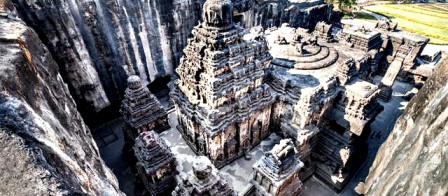Post Mauryan Society and Trade – History Study Notes & Stuff
Internal and External Trade Routes:
The most important feature after the Mauryan period was its growth in trade and commerce, development internally as well as externally in the country. There were two major internal land routes in ancient India which was formerly known as Uttarapath which connected the northern and eastern parts of India to the northwestern shores of present-day Pakistan and beyond. The second land route was known as Dakshinapath which connected peninsular India to the western and northern parts of India.
Dakshinapath was the major route connecting North and South India and it started from Kaushambi near Allahabad and extended through Ujjayini to Bhriguchacha (Broach), an important port on the west coast. Dakshinapatha was associated with Satavahana capital establishment (modern Paithan). As the external trade routes are concerned, after the monsoon discovery by Hippasus, who was a Greek sailor in 45 AD, more and more sea voyages were used for trading purposes. Important ports of India on the western coast where Muziris, Kalyana,and Bharukachchha Sopara, from north to southern direction.
Ships from these ports sailed through the Red Sea to the Roman Empire. Trade with Southeast Asia was done through the sea. The major ports on the east coast of India were Tamralipti in West Bengal and Arikamedu on the Tamil Nadu coast. Maritime trade was also carried out between the ports of Bharukachchha and southeast Asia.
Establishment of trade between West and Central Asia:
An important feature of the post-Mauryan period was the thriving trade between India and the West of the Roman Empire. Initially this trade was carried out through land, but due to frequent blockages by the Persians, the people who ruled the areas from which these trade routes passed were shifted to sea routes. Now ships could sail directly from Indian ports to ports located on the Red Sea and the Persian Gulf. The best account of Indo-Roman trade is given in a book called Periplus of Erythrin Sea which was written by an anonymous writer in the first century AD. The main requirements of these Romans were products from India such as spices, perfumes, jewelry, ivory and fine textiles, ie muslin. Spices were exported from India to the Roman Empire, including black pepper, which was also known as 'Yavanapriya' due to the high popularity among the Romans.
The spice trade was based in South India with the Roman Empire. The Romans imported many variety of precious and semi-precious stones like like diamonds, carnelian, turquoise, agate, sapphires. They also imported pearls, indigo, steel and sandalwood from India.
In exchange of this import Romans exported gold and silver to India. This is proved by the large number of Roman coins dating to the first century AD discovered in the subcontinent. These western traders also brought other things like lead, slave girls, tin, wine and coral.
Indian Craft Production in Post-Mauryan Period:
In this period craft production began to increase with tremendous speed, as trade and commerce, both internal and foreign, dependent heavily on craft activities. The text work 'Milindapanho' mentions 75 types of occupations, 60 of which were entirely related to crafts. The level of expertise in the craft was very high and there were different artisans working in materials like gold, silver and precious stones etc.
The city of Ujjain was a major bead-making center. The textile industry was another major industry. Vanga (East Bengal) and Mathura were very famous for various types of cotton and silk textiles. The discovery of "dye vats" at various sites in southern India indicates that "dye the clothes" was a thriving craft in the region in the post-Mauryan period.
The artisans of this period reached new heights of prosperity and there are many inscriptions which refer to the donations made by the craftsmen to the monasteries.
Trade and Merchant Guilds:
The communities of merchants who were organized into groups were known as Shreni (guilds). Saratha was another type of mercantile group, representing caravan trading corporations of inter-regional merchants. These leaders of such guilds were called Sarthavaha.
Like the merchants, largely all craft vocations were organized as guilds, under a headman called Jyeshta. These included bamboo workers, Weavers, corn sellers, oil makers, potters and others. The guilds were basically association of merchants and craftsmen who following the same profession or dealing in the same commodity. They chose their head and formulated their own rules regarding prices and quality etc. to regulate their business on the basis of mutual goodwill. They also worked as a banker and received deposits at fixed interest rates from the public.
If you want us to add any more details to this article, please do let us know in the comments below.








0 Comments